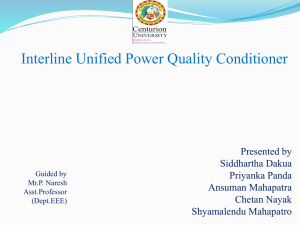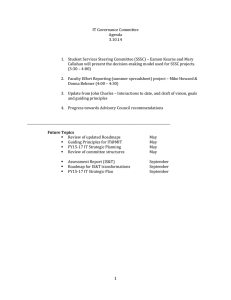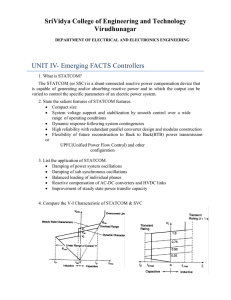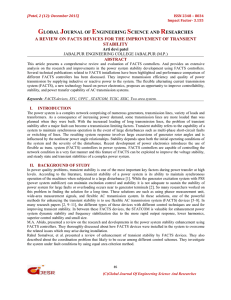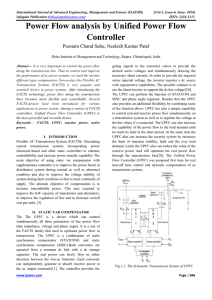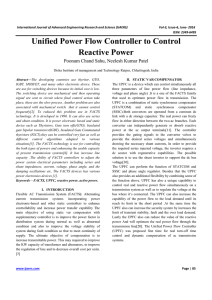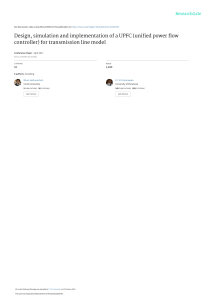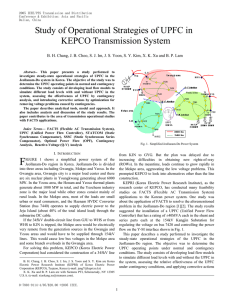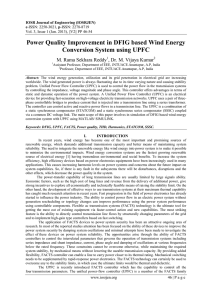Undergraduate research project
advertisement
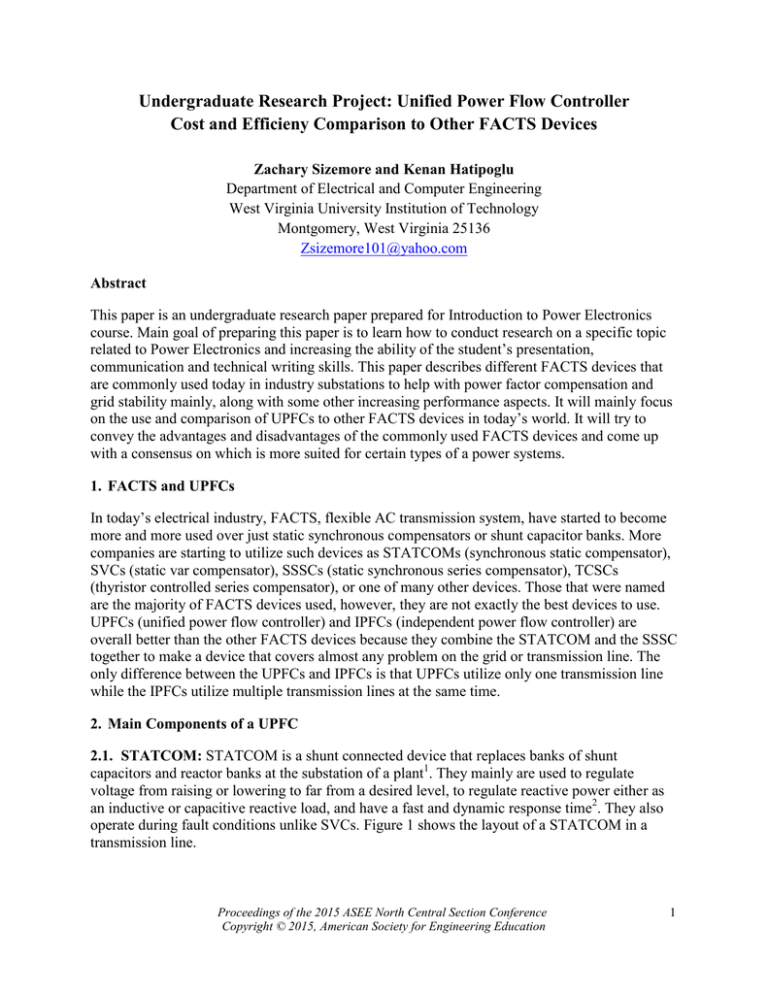
Undergraduate Research Project: Unified Power Flow Controller Cost and Efficieny Comparison to Other FACTS Devices Zachary Sizemore and Kenan Hatipoglu Department of Electrical and Computer Engineering West Virginia University Institution of Technology Montgomery, West Virginia 25136 Zsizemore101@yahoo.com Abstract This paper is an undergraduate research paper prepared for Introduction to Power Electronics course. Main goal of preparing this paper is to learn how to conduct research on a specific topic related to Power Electronics and increasing the ability of the student’s presentation, communication and technical writing skills. This paper describes different FACTS devices that are commonly used today in industry substations to help with power factor compensation and grid stability mainly, along with some other increasing performance aspects. It will mainly focus on the use and comparison of UPFCs to other FACTS devices in today’s world. It will try to convey the advantages and disadvantages of the commonly used FACTS devices and come up with a consensus on which is more suited for certain types of a power systems. 1. FACTS and UPFCs In today’s electrical industry, FACTS, flexible AC transmission system, have started to become more and more used over just static synchronous compensators or shunt capacitor banks. More companies are starting to utilize such devices as STATCOMs (synchronous static compensator), SVCs (static var compensator), SSSCs (static synchronous series compensator), TCSCs (thyristor controlled series compensator), or one of many other devices. Those that were named are the majority of FACTS devices used, however, they are not exactly the best devices to use. UPFCs (unified power flow controller) and IPFCs (independent power flow controller) are overall better than the other FACTS devices because they combine the STATCOM and the SSSC together to make a device that covers almost any problem on the grid or transmission line. The only difference between the UPFCs and IPFCs is that UPFCs utilize only one transmission line while the IPFCs utilize multiple transmission lines at the same time. 2. Main Components of a UPFC 2.1. STATCOM: STATCOM is a shunt connected device that replaces banks of shunt capacitors and reactor banks at the substation of a plant1. They mainly are used to regulate voltage from raising or lowering to far from a desired level, to regulate reactive power either as an inductive or capacitive reactive load, and have a fast and dynamic response time2. They also operate during fault conditions unlike SVCs. Figure 1 shows the layout of a STATCOM in a transmission line. Proceedings of the 2015 ASEE North Central Section Conference Copyright © 2015, American Society for Engineering Education 1 Figure 1: Example of a STATCOM in Transmission line. 2.2. SSSC: The static synchronous series compensator is a series FACTS device that utilizes power electronics to control power flow and improve power oscillation damping on power grids. The SSSC injects voltage in series with the transmission line and depending on the voltage a function will be performed as a variable reactance compensator either capacitive or inductive3. An example of SSSC in the transmission line with control diagram can be seen at Figure 2. Figure 2: Example of SSSC in the transmission line with control diagram. 3. Power Electronics in UPFCs There are no power electronics that are specifically inside the UPFC, however, there are power electronics inside both the STATCOM and SSSC. The STATCOM has a 3 phase PWM inverter/rectifier and IGBT circuit. The SSSC has either an IGBT-based with PWM inverter/rectifier or GTO-based square wave inverter/rectifier. Layout of an UPFC with power electronics can be seen at Figure 3. Proceedings of the 2015 ASEE North Central Section Conference Copyright © 2015, American Society for Engineering Education 2 Figure 3: Layout of an UPFC with power electronics 3.1. Power Electronics in STATCOM: The 3 phase PWM bridge rectifier/inverter is used for voltage-source conversion in both directions AC to DC and DC to AC respectively. It controls the amount of active power exchanged between the ac source and the dc source along with the direction that the active power flows4. This allowed for power factor correction to very high degree. STATCOMs also have an IGBT circuit which is used for the fast switching time to change between degrees of inductance or capacitance or switching between the two to help create a fast and dynamic power factor correction. 3.2. Power Electronics in SSSC: SSSCs have two setups either GTO-based or IGBT-based. They both have an inverter/rectifier setup but it is different based on the gates used. If you use a GTO-based setup then the voltage used to create the output is a 48-step waveform so that it is essentially and array of linear voltages creating a waveform3. This allows for no harmonics to be introduced into the system. If you use an IGBT-based setup, than you use a sinusoidal waveform from DC voltage and a chopper circuit to make the output voltage, and the circuit needs a filter to cancel out the harmonics it produces as well3. 4. Equation used in UPFCs There are a couple common equations used for the overall outcome of a UPFC onto the transmission line. Those equations are E2= E1 + E3, which represents voltage and angle, P1=P2, represents active power in the system, and lastly Q1 =/= Q2, representing reactive power in the system. Layout of an UPFC with power electronics can be seen at Figure 3. Proceedings of the 2015 ASEE North Central Section Conference Copyright © 2015, American Society for Engineering Education 3 If you look at the first equation and compare it to the diagram at Figure 4 we are looking at the values on the graph Vm∟Θm which represents E2 and the overall voltage and angle that is leaving the UPFC and going to the load side which is equal to V∟Θ, at the transformer in series with the SSSC, and Vk∟Θk, which is the generator side voltage. This voltage can go the other direction too in some cases. Secondly, we have P1=P2 which refers to the active power in both sides of the UPFC: the STATCOM and the SSSC. The shunt and series side active power have to be the same at all times. Lastly, Q1=/=Q2 which represents the reactive power difference in the shunt and series side. This is due to the power factor correction that is happening in the UPFC to affect the transmission line and load. Figure 4: Circuit layout of a UPFC. 5. Comparison of the UPFC to other FACTS Today in the grid system we use in America and the world more and more companies are implemented FACTS devices into their generation of power. The first UPFC was in implemented into the Inez substation in Kentucky, US in 1999. Still today there is not another in North America and I do not think another in the world due to many contributing factors. The biggest factors are grid congestion, cost, load growth, renewable energy, and grid reliability1. There is also to consider what aspects each FACTS device can achieve the best result in the following: load flow control, voltage control, transient stability, and dynamic stability1. You have to consider all these things when implementing FACTS devices into your system and the overall grid. Proceedings of the 2015 ASEE North Central Section Conference Copyright © 2015, American Society for Engineering Education 4 Only as recently as 2010 to 2013 have companies really started converting their substations to FACTS devices though. The main reason being is cost of replacing their static systems in place, static series compensators for SSSCs and TCSCs and synchronous condensers for SVCs and STATCOMs. FACTS devices help the grid system’s reliability a lot and would help stabilize our overall electrical system when a majority of companies replace their static sources with FACTS sources. General comparison of FACTS devices can be seen at Figure 5. Figure 5: General comparison of FACTS devices. 5.1. Downsides to Switching from Static Sources: There are not many downsides to switching from static sources to FACTS devices other than cost. Cost is the main reason a lot of companies avoided upgrading to FACTS because they would have to pay not only for the FACTS device(s) which could be in the millions of dollars, but also the safe removal of their existing devices and the loss of production during installation and removal of the static devices. They have to purchase filters for most FACTS devices due to additional harmonics produced as another additional cost. It will also take a quite a bit of time for the company to break even on the new device(s) too. 5.2. Upsides to Switching from Static Sources: There are a lot of upsides for the overall electrical system to switch to FACTS devices. The biggest improvement is the stability of the system in all aspects is increase, the line impedance, voltage control, and load flow control. This helps increase the grid reliability when all these things are increased in stability. Another huge upside is that it helps curb load growth issues a little easier than static devices do. SVCs and STATCOMs help regulate voltage more accurately and increase power transfer capacity better than capacitor banks and reactor banks while also allowing voltage support during fault conditions1. SSSCs and TCSCs would replace static series compensators and would increase transmission line impedance to increase overall power flow transfer and more importantly do not generate sub-synchronous resonance like the static series compensators which limits transmission flow substantially1. 5.3. Comparisons between Similar FACTS Devices: 5.3.1. Series Devices: In general the main two series devices are SSSC and TCSC. They do similar actions; however, they do them in different ways. The main difference, which is really the only one worth mentioning, is how they handle sub-synchronous resonance. The SSSC reduces the resonance but leaves the oscillations of the system higher than what would be wanted Proceedings of the 2015 ASEE North Central Section Conference Copyright © 2015, American Society for Engineering Education 5 in the system5. The TCSC reduces the resonance in a manner that it dampens the critical torsional mode and has a constant reactive voltage which leads to the reduction in resonance and electrical resonance frequency, which makes the possibility of destabilizing the torsion when the series resistance is close to zero5. 5.3.2. Shunt Devices: The main shunt devices used are the SVC and STATCOM. They have a small difference between them when it comes to how fast they switch between different reactive power needs and how effective they are at lower and higher AC voltages. They both can regulate voltage, supply reactive power compensation, and can act as an inductive or capacitive compensation. Due to IGBTs in the STATCOM it has a faster response time and thus switches between the reactive needs faster making it more efficient and beneficial to the grid system but when subjected to high AC voltages it no longer provides its maximum reactive power and thus falls short of the SVC’s capabilities6. 6. Conclusion UPFCs are the best performing FACTS device we can produce and as many companies that can upgrade to utilize these device should. It would help our electrical grid system entirely and allow for their company to be more efficient and helpful to the system. Due to its high cost though I can see why many choose to use lesser FACTS device or none at all. It would be a major step if all companies would at least implement any FACTS devices instead of static devices. I think this is the next big step to improving our grid network and power system as whole in America and the globe because it would improve reliability, stability and efficiency. Bibliography 1. "Advanced Transmission Hardware." WESTGOV.org. WESTERN INTERSTATE ENERGY BOARD, 27 Mar. 2013. Web. 23 Apr. 2014. http://www.westgov.org/wieb/meetings/crepcsprg2013/briefing/03-27-13BVdrft.pdf. 2. "STATCOM." Gamesa Electric. Gamesa Electric, 1 Jan. 2012. Web. 23 Apr. 2014. http://www.gamesaelectric.com/index.php?option=com_content&task=view&id=208&Itemid=340&lang=en 3. "Static Synchronous Series Compensator (Phasor Type)." MathWorks. N.p., 1 Jan. 2014. Web. 23 Apr. 2014. http://www.mathworks.com/help/physmod/sps/powersys/ref/staticsynchronousseriescompensatorphasortype.ht ml. 4. "Renewable Energy." LabVolt.com. N.p., 1 June 2012. Web. 22 Apr. 2014. https://www.labvolt.com/downloads/86366_f0.pdf. 5. Padiyar, K. , and Nagesh Prabhu. "A Comparative study of SSR Characteristics of TCSC and SSSC."pscc.com. Indian Institute of Science Bangalore, India, 25 Aug. 2005. Web. 23 Apr. 2014. http://pscc.ee.ethz.ch/uploads/tx_ethpublications/fp36.pdf. 6. "STATCOM." LabVolt.com. LabVolt, 1 Aug. 2012. Web. 23 Apr. 2014. https://www.labvolt.com/downloads/86371_F0.pdf. Proceedings of the 2015 ASEE North Central Section Conference Copyright © 2015, American Society for Engineering Education 6
